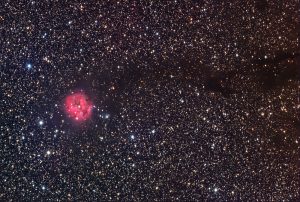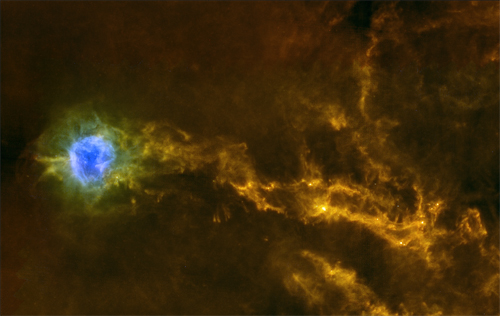| Basic Information | |
| What is this? | Interstellar Cloud IC5146, containing the Cocoon Nebula |
| Where is it in the sky? | In the constellation of Cygnus the Swan |
| How big is it? | The region is around 15 light years across |
| How far away is it? | Around 1500 light years away |
| What do the colours represent? | Red shows colder gas and dust, while blue and green are warmer material which is being heated by stars which have already formed |
Downloads
See this object in:

The interstellar cloud IC5146 contains the Cocoon Nebula, seen on the left, which is connected to a network of filaments of dust and gas. Stars form along the densest parts of these filaments, but how the filaments form has been a mystery. In optical light, the gas and dust look like opaque stripes (see right), and it is only in the infrared that they can be seen in detail. The resolution of Herschel has allowed astronomers to measure the widths of the filaments. Suprisingly, they were all found to be almost the same width, rather than having a wide range as was expected. This gives a clue as to their formation.
By comparing with computer simulations, the astronomers have concluded that the filaments may be formed when slow shockwaves dissipate in the interstellar clouds. The shockwaves are the result of the energy produced by exploding stars, which cause a great deal of turbulence in the surrounding regions. These shockwaves travel through the Galaxy, sweeping up gas and dust and forming the dense filaments we see today.
Since the interstellar clouds are extremely cold, at around 10 degrees above absolute zero (or -263 Celsius), the speed of sound is relatively slow – at just 200 m/s (450 mph), compared with 340 m/s (760 mph) at sea level here on Earth. This means that the slow shockwaves are the interstellar equivalent of sonic booms. As they lose energy in the clouds, they leave behind these tenuous filaments of gas and dust.
This region in the constellation of Cygnus is around 1500 light years away, and is part of the Gould Belt, a ring of similar star forming regions around the sky, which is being studied by Herschel as part of the “Gould Belt Survey”.

